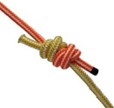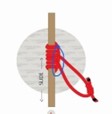5.0 The History and Importance of Knots
Knots have played a crucial role in human safety for thousands of years. From ancient sailors navigating by sail, to mountaineers scaling alpine peaks, and to today’s rope access technicians, knotwork remains a critical life-safety skill.
One of the most famous early examples of knots saving lives comes from the 1936 rescue attempt on the Eiger North Face, one of the most feared and legendary alpine climbs in the world. Known for its brutal weather and deadly exposure, the Eiger claimed the lives of
multiple climbers attempting to summit its notorious north face. In July 1936, a German- Austrian team became trapped on the face after a storm moved in. Rescue efforts were organized from the nearby town of Grindelwald using long, fixed ropes and carabiners — both still in their early stages of development. Swiss guides and rescuers used makeshift belay techniques and rudimentary knots such as the bowline and alpine butterfly to establish a rescue system.
The story became iconic after a climber named Toni Kurz, the last surviving member of the trapped team, hung on a rope for over 24 hours in freezing conditions. As rescuers attempted to reach him from below, Kurz tried to rappel the last few meters — but became stuck because of a jammed knot. His last words were “Ich kann nicht mehr” (“I can’t go on”). This tragic but heroic attempt later influenced the development of more advanced rescue knot systems and belay techniques, which have shaped how rope professionals operate today.
Today’s rope access systems owe much of their development to stories like this — showing that knots can mean the difference between life and death.
5.1 Knot Descriptions
|
Knot |
Description |
Load Retention |
Use Case |
Image |
|
Fig-8 on a Bight |
Simple, strong loop knot tied at rope end. Easy to inspect. |
75-80% |
|
|
|
Alpine Butterfly |
Mid-rope knot ideal for multidirectional loading. |
75-80% |
|
|
|
Bowline |
Loop knot that is easy to tie/untie. Not secure under cyclic loading. |
60-70% |
|
|
|
Triple Bowline |
Variation of bowline with three loops for rescue harness applications. |
65-70% |
|
|
|
Double Fisherman’s |
Secure knot used to join two ropes. Difficult to untie after loading. |
65-70% |
|
|
|
Prusik |
Friction hitches that grips rope under load but slides when slack. |
Varies |
|
|
|
Munter Hitch |
Hitch for belay or lowering without mechanical descender. |
60-70% |
|
 |








